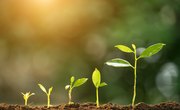How Seeds Are Produced
The production of seeds in plants requires both male and female plants. The male plants produce pollen which is then carried to a female plant by birds, bees, insects or wind. The pollen makes its way inside the female plant, where it connects with the ovaries and produces seeds. The female plants then project the seeds outward to be dropped in the surrounding soil to produce offspring.
How Pollination Works
In order for seeds to be produced, plants must first be pollinated by insects and animals in their surrounding ecosystem. Many plants and flowers attract birds, butterflies, bees and others by having large colorful flowers, or by having a large, elaborate decoration near where the pollen or ovaries are located.
Pollen is produced on the stamen inside male plants, which is often decorative and attractive to bees and insects. While male and female plants may grow close to one another, they cannot reproduce without the help of wind and creatures. Plants produce pollen as a source of food for insects and animals in order to attract them, but it is also essential to their reproduction. When bees, birds or insects touch pollen, it sticks to them. Then when they go to a female plant to feed on the pollen, the pollen is dropped onto the female plant's pistil, where it travels to the ovaries, where seeds are then produced.
It can take anywhere from a week to a year for seeds to be fully developed inside the plant. It depends on the species and how many seeds it is producing. Some fruit-bearing plants take much longer to produce fruit, which contain the seeds produced by the plant.
Seed Dispersal
Seeds ensure that more of that particular species will carry on, and many plants produce hundreds, even thousands, of seeds at once in hopes of just getting one additional plant to sprout. Seeds can survive a long time in the ground before rooting and producing a plant or flower. Some plants drop seedlings in the fall that don't produce a plant until spring. Some plants can produce multiple rounds of seeds in a season. Some flowers are able to be pollinated once, drop their seeds, and then get pollinated again and reproduce more seeds. This cycle can continue over and over throughout that season until a frost, or until the mother plant dies. Other plants may only produce one round of seedlings, and then die. Some plants are perennials, meaning that they return each year, while annuals may only live for one season.
Once these new seedlings have been dropped by the mother flower and they begin to grow on their own, they will then repeat the cycle and produce more seeds the same way as their mother and father plants did, using pollen.
References
About the Author
Lauren Farrelly has been writing and producing for television since 2003. She has experience covering sports, business news and general news events for CNBC, ESPN and Bleacher Report. Farrelly has a BA in broadcast journalism from Arizona State University.
